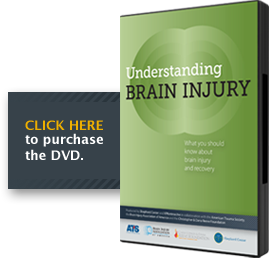Glossary of Terms You May Hear
Anoxia (or hypoxia)
Lack of oxygen; can be caused by heart attack, airway obstruction, near drowning, lightning strike or even electrical shock
Axonal shearing
When the brain’s axons (main channels of communication) are stretched to the point of breaking, causing damaged brain cells to die
Brain herniation
Rising pressure inside the brain or hematoma causing parts to shift out of place
Cerebral atrophy
Loss of nerve cells in the brain and the connections between them
Coma
Deep state of unconsciousness. Patient cannot be aroused, does not respond to stimuli, and cannot make voluntary actions. It can be medically induced to give the brain time to heal.
Coma Recovery Scale
Measures hearing and vision, movement and communication, arousal, etc. to help determine the patient’s long-term prognosis. It can also be used throughout rehabilitation to gauge the recovery progress.
CT Scan (Computerized Tomography)
Gives doctors more detailedinformation about spinal cord or brain damage than X-rays can show
Edema
Swelling inside the skull, squeezing brain cells, or interrupting blood flow and oxygen to brain tissue
Healthcare advocate
A person who works directly for the patient or family for a fee, helping with paperwork, billing and management of post-trauma care
Hematoma
Pool of blood or bruise inside the skull caused by damaged blood vessels. It can increase pressure inside the brain.
Hemorrhage
Internal or external bleeding caused by damage to ablood vessel
Intracranial pressure monitoring
Monitoring of the pressure inside the skull
Mild traumatic brain injury (TBI) (concussion)
Patient may initially lose consciousness for 15 minutes or less; may experience memory loss about the trauma event; likely to feel dazed, disoriented or confused. Most traumatic brain injuries are initially rated as mild.
Minimally conscious state
A condition of severely altered consciousness in which minimal, but definite, behavioral evidence of self or environmental awareness is demonstrated
Moderate traumatic brain injuries (TBI)
Patient may initially lose consciousness for 15 minutes to a few hours; similar, but more significant symptoms than mild TBI
MRI (Magnetic Resonance Imaging)
Uses a strong magnetic field and radio waves to produce computer-generated images. It can help identify blood clots, swelling or skull fractures that may be compressing the brain and/or spinal cord.
Neuropsychological assessment
Series of tests evaluating multiple aspects of the mind, including basic hand-eye coordination, higher-level thinking and cognitive skills necessary for everyday functioning
Occupational therapist
Skilled in helping individuals learn, or relearn, the day-to-day activities they need to achieve maximum independence
Physiatrist
Doctor specializing in physical medicine and rehabilitation
Physical therapist
Treats disabilities that result from motor and sensory impairments
Recreational therapist
Helps patients discover the wide range of recreational options they may be able to participate in and trains them to do so
Rehabilitation nurse
Nurse with special training in rehabilitative andrestorative medicine
Semi-coma or vegetative state
A patient’s eyes may open, but they are not aware of themselves or their surroundings.
Severe traumatic brain injuries
A patient may have a loss of consciousness for six hours or longer after injury or after a period of clarity. People remaining unconscious for a lengthy time may be in a coma, or a vegetative or minimally conscious state.
Shock
Body response triggered by loss of blood to the brain, which canindirectly injure brain tissue
Stroke
Interruption of blood flow to any part of the brain caused by an artery blockage, hemorrhage or aneurysm. A decrease in blood flow results in little or no oxygen reaching brain cells. It is sometimes called a “brain attack.” Stroke effects depend on where the stroke occurs in the brain and how much of the brain is damaged.
Sympathetic storming
Stress response such as agitation, fever, irregular vital signs and excessive sweating. It can occur anytime from 24 hours to a week after the injury and is thought to be a sign of returning activity of the sympathetic, or protective, nervous system.
Vocational therapist
Helps people assess their job skills/readiness and return-to-work options
Produced by Shepherd Center and KPKinteractive in collaboration with the American Trauma Society, the Brain Injury Association of America and the Christopher & Dana Reeve Foundation.









